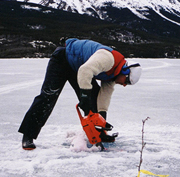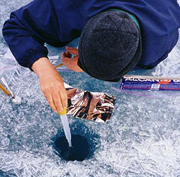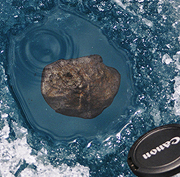Official Name:
This meteorite is not named for a town, but for the frozen lake on which it fell.
Location:
In the part of Tagish Lake called Taku Arm, just south of the border between British Columbia and the Yukon, in Canada.
Fall or Find:
Fall
Date:
18 January 2000, 8:43 a.m. local time.
Mass Recovered:
Approximately 10 kilograms.
Number of Fragments:
According to scientific estimates, this very fragile meteorite split apart into more than 10 000 fragments. A few hundred fragments have been recovered.
Strewn field:
The strewn field is 16 by 3 kilometres. It probably went beyond the shores of the lake, although so far, no fragment has been found on firm ground.

Enlargement
Several photographs and films exist of the dust trail left by the passage of the meteoroid. |
|

Enlargement
Location of the Tagish Lake meteorite fragments discovered on the lake. |
|
Circumstances: The meteoroid was detected by U.S. Department of Defense satellites when it entered our atmosphere. According to their observations, the object weighed 200 metric tons and was 5 metres in diameter. The fireball was exceptionally long and bright. Several citizens witnessed it. Inhabitants of the town of Carcross, in the Yukon, heard the explosion caused by the fragmentation. Some citizens reported an odour associated with the passage of the fireball.
A local resident named Jim Brook discovered the first pieces of the meteorite. On January 25 and 26, 2000, he recovered several dozen fragments. He avoided contaminating the pristine meteorites by picking them up with his hands in plastic bags and keeping them in the freezer until scientists arrived. Several scientific expeditions went to the site during the winter and spring. The goal was to recover as much material as possible from this unique meteorite.
Although a few specimens weighing several hundred grams were extracted intact, it was mostly small aggregates and particles that were recovered in the ice. To recover the small fragments lying at the bottom of the lake, scientists used kitchen utensils such as ladles, chopsticks, and turkey basters!

Enlargement
Recovering meteorite fragments from the ice on the lake. |
|

Enlargement
Using a turkey baster to recover fragments. |
|
History:
The recovery of the Tagish Lake meteorite is itself a historic event. Because the meteorite fragments landed on ice, quick action was needed. The blackened meteorites were being heated by the Sun and were sinking into the ice, becoming less visible. In addition, they were resting in small pools of water, which was accelerating their deterioration. Lastly, the stones had to be recovered before the ice in the lake melted. Over 234 people worked to collect the meteorites from the fall site!
Type:
Stony meteorite
Class:
Carbonaceous chondrite
Group:
C2

Enlargement
Intact meteorite fragment that melted the surrounding ice. |
|

Enlargement
Meteorite particles still trapped in the ice. |
|
Composition:
Examination of the meteorite revealed the presence of olivine, chondrules, calcium-aluminum inclusions, magnetite, and carbon compounds. Tagish Lake could not be classified in a known sub-group of carbonaceous chondrites. It is part of a new, more primitive group called C2. Its darker, reddish colour is evidence of its uniqueness.
The Tagish Lake parent body had not been altered by heat since its formation 4.5 billion years ago. The landing on frozen ice preserved some fragments in their original condition.
Tagish Lake probably came from a rare type D asteroid in the outer portion of the asteroid belt. Scientists reached this conclusion by comparing the solar light reflected by the meteorite to that reflected by other asteroids of this type.
Scientific contribution:
The satellite photos of the Tagish Lake fireball made it possible to determine its trajectory, velocity, and where it came from. It is one of the few meteorites, and the first carbonaceous chondrite, whose orbit is known.
Comments:
The event is unique due to the initial size of the parent meteoroid, the rarity of this type of meteorite, its wealth of organic compounds, its age, its fragility, and the substantial amount of material that was recovered.
Part of the Planétarium's collection:
Yes